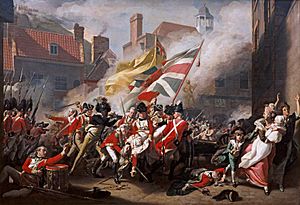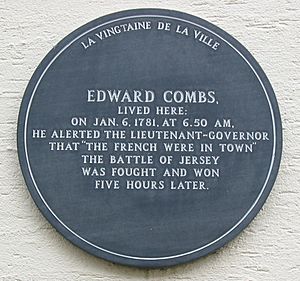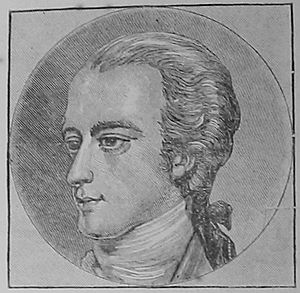Battle of Jersey facts for kids
Quick facts for kids Battle of Jersey |
|||||||
|---|---|---|---|---|---|---|---|
| Part of the Anglo-French War (1778–1783) and American War of Independence | |||||||
 The Death of Major Peirson, 6 January 1781, John Singleton Copley |
|||||||
|
|||||||
| Belligerents | |||||||
| Commanders and leaders | |||||||
| Strength | |||||||
| 2,000 | 1,400 | ||||||
| Casualties and losses | |||||||
| 71 killed and wounded | 158 killed and wounded 600 captured |
||||||
The Battle of Jersey happened on January 6, 1781. French forces tried to invade the British island of Jersey during the Anglo-French War (1778–1783) and the American Revolutionary War. They wanted to stop British ships called privateers from using Jersey as a base.
The French lost the battle, and nearly half their soldiers were killed or captured. Their leader, Baron Philippe de Rullecourt, died from his injuries. The battle is also famous because the British commander, Major Peirson, was killed. A famous painting by John Singleton Copley shows his final moments.
Contents
Why Jersey Was Important
Jersey is an island very close to France, only about 14 miles (22 km) away. It was also on a main shipping route to a French naval base. This made Jersey a very important place during any war between Britain and France.
Many British privateers used Jersey as a base. Privateers were like legal pirates, allowed by their government to attack enemy merchant ships. These privateers caused a lot of trouble for French merchant ships, even as far away as America.
The French government wanted to stop these attacks. They also thought attacking Jersey might make Britain send soldiers away from the Great Siege of Gibraltar, which was happening at the same time.
How Jersey Was Protected
The British knew Jersey was important, so they built many defenses. In 1778, the island's governor, Field Marshal Henry Seymour Conway, planned to build 30 round towers to help defend the coast. King George III approved this plan.
By the time of the battle, a few towers were ready. There were also gun batteries, forts, and other defenses along the coast. All adult men in Jersey had to serve in the Jersey Militia. In 1780, this militia had about 3,000 men.
British regular troops were also stationed on the island. These included different regiments like the 71st, 78th, 83rd, and 95th Regiments of Foot. There were also about 700 "Invalids," who were semi-retired soldiers. In total, Jersey had about 6,250 troops ready to defend it. A British naval force, the "Jersey Squadron," was usually there, but they were away fighting the Dutch during the invasion.
A Failed French Attack in 1779
The French had tried to invade Jersey before. On May 1, 1779, a French force led by the Prince of Nassau-Siegen tried to land at St Ouen's Bay. British and Jersey militia soldiers quickly moved to the beaches.
They brought cannons and fired at the French ships. The defenders stopped the landing, and the French ships had to leave. Only a few British soldiers were hurt.
The French Plan for 1781
Even though some French military leaders thought attacking Jersey was a bad idea, the government approved a new plan. This plan came from Baron Philippe de Rullecourt, who had been with the Prince of Nassau-Siegen in the earlier attempt. De Rullecourt was an adventurer and a colonel in the French Army. King Louis XVI promised him a higher rank if he could capture Saint Helier, Jersey's capital.
Another commander was an Indian prince named Mir Sayyad. He had fought with France before. Sayyad suggested that the French should burn the town and kill everyone. But De Rullecourt did not follow his advice.
The French government secretly funded this attack. They even ordered some of their regular soldiers to pretend to "desert" and join De Rullecourt's forces.
On January 5, 1781, the French expedition left Granville, France. There were about 2,000 soldiers in four groups. A storm scattered some ships, and only about 1,200 soldiers made it to Jersey at first.
Jersey was celebrating 'Old Christmas Night' on January 6, so the French landed without being seen. The first group of 800 men landed at La Rocque, Grouville, on the southeast coast. They walked past the guards without being noticed. Later, it was found that these guards had left their posts to go drinking.
The second group of 400 men landed among rocks and were all lost. The third group of 600 men got separated and could not join the main force. The fourth group of 200 men landed early the next morning. So, in total, about 1,400 French soldiers landed on the island.
The Invasion Begins
French Troops Reach Saint Helier
The French first group, about 700 men, marched about four kilometers to St Helier. They arrived between six and seven in the morning on January 6. They entered the market square, which is now called the Royal Square. They surprised the guards and took over the square while most of the town was still asleep.
Around eight o'clock, a French patrol surrounded Government House. They captured the island's governor, Major Moses Corbet, in his bed.
The French took Corbet to the Royal Court House in the market square. De Rullecourt tried to trick Corbet, saying that thousands of French troops had already taken over Jersey. De Rullecourt threatened to burn the town and kill everyone if Corbet did not sign a paper to surrender. Corbet was also told to order the commander at Elizabeth Castle to give up.
Corbet said that as a prisoner, he had no power, and anything he signed would not count. But De Rullecourt insisted. To protect St Helier, Corbet signed the paper.
The French had already asked the commander at Elizabeth Castle to surrender, but he refused. The castle's defenders fired at the French, killing a few men. When the French brought Corbet's written order to surrender, the castle defenders again refused by firing their cannons.
British Get Ready to Fight
The British forces were now alerted. Since Governor Corbet was a prisoner, command went to the next highest officer, 24-year-old Major Francis Peirson. He commanded the troops at Saint Peter's Barracks.
British soldiers and militia gathered on a hill called Mont ès Pendus (now Westmount), west of the town. Peirson quickly had 2,000 men ready. He decided to lead them down the hill to attack the town.
The French were in the market square. They had taken the town's cannons and placed them to fire at the British. But they did not fire their howitzers. The British learned from people watching the French that there were only about 800 or 900 French soldiers.
Major Peirson sent the 78th Seaforth Highlanders to take Mont de la Ville hill (where Fort Regent is now). This would block any French escape. Once he thought they were in place, Peirson ordered his remaining troops to attack.
The British stopped at the edge of the town. De Rullecourt sent Corbet to tell the British that if they did not surrender, the French would destroy the town in half an hour. Peirson and Captain Campbell replied that the French had 20 minutes to surrender instead.
The British soldiers in other areas also refused to surrender. When De Rullecourt heard this, he said, "Since they do not want to surrender, I have come to die."
The Battle Begins
The attack began. British forces, including the 78th Regiment and various militia groups, advanced into the town. The 95th Regiment and other militia groups came down other streets. The British had many more soldiers than needed for the fight. One British soldier said that a third of their troops would have been enough to defeat the French. Many British soldiers, confused, fired their shots into the air.
The French did not fight for long, with most of the action lasting only 15 minutes. The French only fired their cannons once or twice. The British had a howitzer aimed at the market square. Each shot "cleaned all the surroundings of French," according to a British soldier.
Major Peirson and the 95th Regiment moved towards the market square. As the British were winning, a musket ball hit Major Peirson in the heart, killing him. His sad troops, now led by Philip Dumaresq, rushed forward and kept fighting.
When De Rullecourt was wounded and fell, many French soldiers gave up. They threw down their weapons and ran away. Others went into the market houses and kept firing.
De Rullecourt, through Corbet, told the British that the French had more soldiers at La Rocque who could arrive in 15 minutes. But the British were not scared. They knew that fewer than 200 French troops had landed that morning.
A group of 45 grenadiers from the 83rd Regiment, led by Captain Campbell, fought against 140 French soldiers. When more British troops arrived, the French were defeated. They lost 30 killed or wounded, and 70 were taken prisoner. Seven British grenadiers were killed in this fight. The remaining French soldiers scattered across the countryside, trying to reach their boats. Many were captured by local people.
Battle Ends
The British captured 600 French prisoners, who were sent to England. The British lost 11 soldiers killed and 36 wounded among their regular troops. Four militia members were killed and 29 wounded. Captain Charlton of the Royal Artillery was also wounded while he was a French prisoner. The French had 78 killed and 74 wounded.
De Rullecourt was badly wounded and died that night at the house of Dr Lerrier in Royal Square. This building is now a pub called The Peirson. He was buried in the grounds of the Parish Church of St Helier.
Captain Lumsdaine said that in just a few hours, the situation changed completely. The enemy ships left the island, and the French soldiers who had landed were either drowned, killed, wounded, or captured.
What Happened Next
Major Peirson was also buried in the Parish Church of St Helier. The people of Jersey built a marble monument there to remember him.
It became clear that some people in Jersey had helped the French. De Rullecourt had detailed plans of Jersey's defenses, including towers and cannons. He had said he wouldn't have come without "good friends" in Jersey. Papers found in his belongings even had the name of a Jerseyman, Mr. Le Geyt, who was later arrested.
Lieutenant-Governor Major Moses Corbet was arrested and put on trial. He was charged with being captured and signing the surrender papers, and for telling others to surrender. Corbet admitted to being captured and signing the document. He was removed from his position as Lieutenant-Governor but was given a pension for life.
The battle showed the importance of Jersey's defenses. Between 1781 and 1814, the government built 19 more of Conway's round towers and three Martello towers to make the island even safer.





